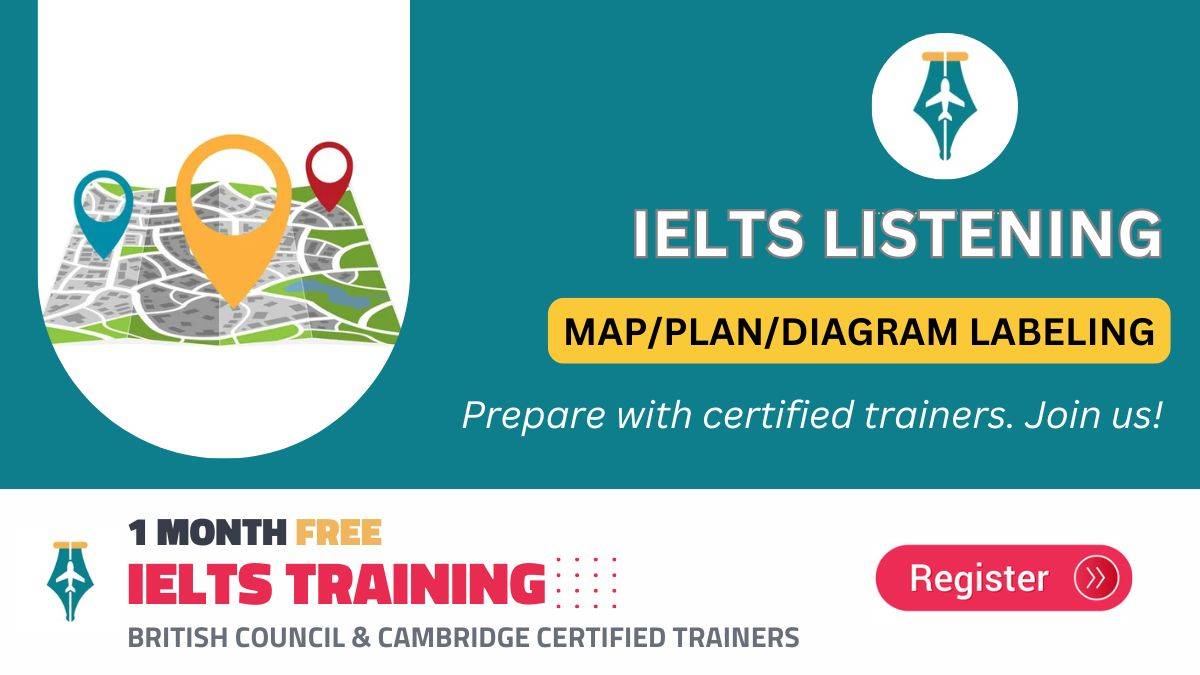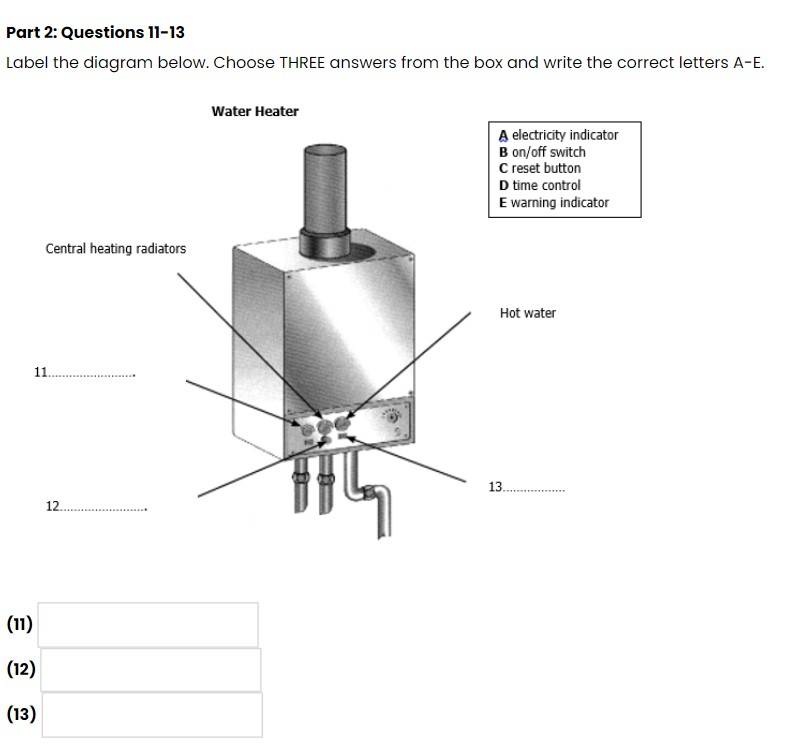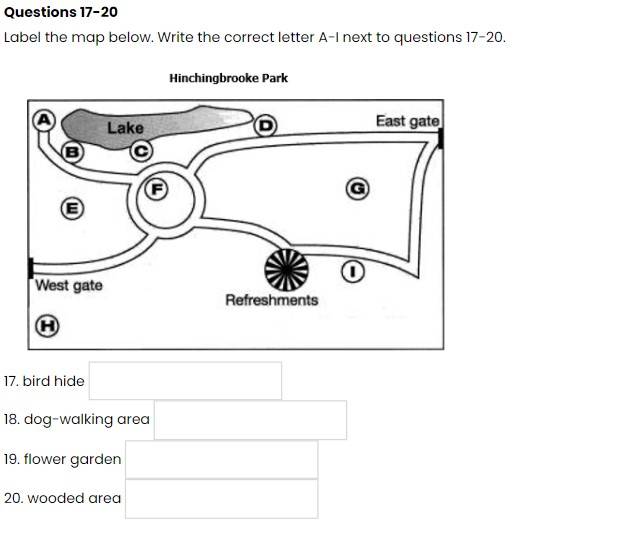Understanding IELTS Listening Map/Plan/Diagram Labeling Question Type
In order to get a higher band score in the IELTS exam, you need to practice this question type as it is very common. The typical structure consists of:
- Maps of tourist destinations or urban regions.
- Blueprints for a structure or a room arrangement.
- Diagrams of systems or items, including machinery or equipment.
You can use the speaker's description to determine parts, locations, or directions. Below are sample questions for reference.
Predict your IELTS, TOEFL, and PTE in just 4 steps!
How to Answer the IELTS Listening Map/Plan/Diagram Labeling Questions?
Diagram, Plan, or Map Labeling questions test your ability to locate places on a map and follow instructions. You must create a strategy plan to respond to these questions efficiently. Here is a thorough, step-by-step guide to help you successfully answer these questions.
1. Preview the Map/Diagram
Before the listening starts, carefully examine the map. This initial scan will help you understand the layout and structure of the area. Key Actions:
- Look for specific features: Identify any marked features or points of reference, such as entrances, gates, lakes, or other prominent areas that may be mentioned in the audio.
- Identify labels: Look for any already labelled areas (e.g., “East Gate,” “Lake,” “Refreshments”). This helps you understand the overall map layout.
- Look for the compass: If a map is provided, check if it has cardinal directions (North, South, East, West) or other directions like “Northwest” or “Southwest.”
- Note the grid/labels: Map areas are often labeled with letters or numbers. Familiarize yourself with them so you can quickly find the locations mentioned in the audio.
2. Look at the directions.
Read the directions carefully to learn how to label the map
- Word Limit: Some questions may specify a word limit, such as “Write one word and/or a number.” Be sure to follow these limits exactly to avoid incorrect answers.
- Multiple Labels: If there are multiple areas to label, based on the audio description, keep track of which letter corresponds to which feature.
3. Anticipate Possible Descriptions
Before listening, try to predict what the audio might describe based on the map. You can expect descriptions of locations and relative positions, such as:
“Near the lake”; “Behind the building”; “To the left of the main entrance”; “Opposite the cafe”
Use your understanding of the layout to make some educated guesses about where certain features might be.
4. Listen Actively and Track the Descriptions
As the audio begins, focus entirely on the speaker and actively listen for the following:
- Spatial references: Listen for key phrases indicating location, such as “next to,” “behind,” “opposite,” “near,” or “in front of.”
- Directions: Pay attention to directional cues such as “turn left,” “walk straight,” “move towards the east,” or “follow the path north.”
- Order of description: Keep track of the sequence in which locations are mentioned. The speaker will often describe landmarks in a logical order, which helps you figure out which area is being described at each point.
Tip: Sometimes, the speaker may give directions not immediately obvious on the map. Keep listening until you have enough information to confidently place each location.
5. Label the Map
As the speaker describes the locations, label the areas on the map along the way. Don’t wait until the end of the audio to start labeling the map. As soon as you hear a description of a location, immediately write the correct letter next to the question number.
6. Check Your Answers
Once the recording ends, review your answers to ensure all locations are correctly labelled and match the descriptions from the audio. Ensure each label corresponds to the correct feature on the map. Double-check for mistakes or confusion in directions.
Common Vocabulary in Map/Plan/Diagram Labeling
Directional Language
- Left/Right: “Turn left,” “on the right side.”
- Straight Ahead: “Go straight,” “directly ahead.”
- Opposite: “Opposite the main gate.”
- Adjacent: “Adjacent to the café.”
Cardinal Directions
- North, South, East, West: “To the north of the park.”
- Northwest, Southeast: “In the northwest corner.”
Prepositions of Location
- Next to/Beside: “Next to the fountain.”
- Between: “Between the library and the café.”
- Behind: “Behind the main building.”
- In front of: “In front of the entrance.”
Sequence and Order Words
- First, Then, After That: “First, enter through the west gate. Then go straight ahead.”
- Before/After: “Before the bridge, turn left.”
- Finally: “Finally, you’ll find the gallery on your right.”
Do’s & Don't's in IELTS Listening Map/Plan/Diagram Labeling
Below are some effective tips and strategies that will help you perform well in this section, along with Do’s and Don’ts to remember.
| Do’s |
Don’t’s |
| Familiarize yourself with the map first. |
Don't rely on assumptions—listen carefully. |
| Label locations immediately as you hear them. |
Don't focus on one question for too long. |
| Use spatial clues (left, right, behind). |
Don't forget to check the instructions. |
| Stay organized with your answers. |
Don't get distracted by small errors. |
| Review answers if time permits. |
Don't make assumptions based on vague descriptions. |
| Listen carefully for key directional words. |
Don't let mistakes with one label affect your focus. |
| Pay attention to the order of descriptions. |
Don't rush; stay calm and organized. |
| Keep track of landmarks and other key features. |
Top Tips & Strategies for Map/Plan/Diagram Labeling
- Understand the Map/Plan/Diagram: Scan the map/plan/diagram for landmarks and label key locations.
- Listen for Spatial Vocabulary: focus on directional words like "next to" and "across from" and distance phrases like "close to" and "far from" to understand their relationship.
- Use Process of Elimination: Cross out the locations that are already labeled or the ones that do not fit the description.
Frequently Asked Questions
1. What is the Map/Plan/Diagram Labeling question type in IELTS Listening?
Answer: The Map/Plan/Diagram Labeling question type in IELTS Listening requires you to label specific locations on a given map, plan, or diagram based on the audio description. These questions test your understanding of spatial information and directions.
2. How can I prepare for Map/Plan/Diagram Labeling questions in IELTS Listening?
Answer: To prepare, practice different types of maps, plans, and diagrams. Focus on understanding directions, proximity, and location-based vocabulary. Also, practice listening to instructions involving spatial descriptions and familiarize yourself with common phrases used in these types of questions.
3. What strategies can help me answer Map Labeling questions correctly?
Answer: Key strategies include quickly scanning the map before listening, focusing on directional language during the audio (e.g., "next to," "behind"), and labeling immediately as you hear the descriptions. Pay attention to the logical order of the description, use the process of elimination, and double-check your answers.
4. How do I manage time during diagram Labeling in IELTS Listening?
Answer: Manage time by labeling each location as soon as you hear it. Avoid overthinking; if you’re unsure about an answer, skip it and come back later. Allocate time at the end of the listening to double-check your answers, ensuring they align with the map's layout.
5. What are common mistakes to avoid in Map/Plan/Diagram Labeling questions?
Answer: Common mistakes include spending too much time on one label, misunderstanding directional cues, confusing similar-sounding locations, and not reviewing answers if time permits. Also, be cautious of incorrect spelling, as it could result in a lost mark.
6. What vocabulary should I focus on for Map/Plan/Diagram Labeling questions?
Answer: Focus on vocabulary related to directions (e.g., "left," "right," "opposite"), locations (e.g., "next to," "behind," "in front of"), and distance (e.g., "close to," "far from"). Understanding these key terms will help you follow the audio instructions accurately.
7. Can I use the same labelling strategies for all Map/Plan/Diagram questions in IELTS Listening?
Answer: Yes, many of the same strategies apply to all types of Map/Plan/Diagram Labeling questions. However, adapt your approach based on the specific layout, whether it’s a park map, building floor plan, or another diagram. Always focus on the spatial relationships described in the audio.
8. How do Map/Plan/Diagram Labeling questions differ from other listening question types?
Answer: Map/Plan/Diagram Labeling questions focus on spatial awareness and directional language rather than specific details or conversations. This makes them unique as they require you to visualize and connect the descriptions to physical locations or areas on the map or plan.
9. How do I handle Map/Plan/Diagram Labeling questions if I miss a part of the description?
Answer: If you miss a description, don’t panic. Skip the label and continue listening for the next clues. Often, later descriptions will help you determine the correct label, or you can use the process of elimination to narrow down your options.
- Universities in USA1038 Universities
- Universities in Canada174 Universities
- Universities in Australia633 Universities
- Universities in UK175 Universities
- Universities in Ireland32 Universities
- Universities in New Zealand70 Universities
Comments
(1289)
2 months ago
T
9 months ago
R
9 months ago
R
a year ago
M
a year ago
R
a year ago
Hello Mustafijur. If you are looking for assistance with applying to universities abroad. Get in touch with our Shiksha Study Abroad Counsellors and book a counselling session absolutely free, Click Here
a year ago
R
a year ago




